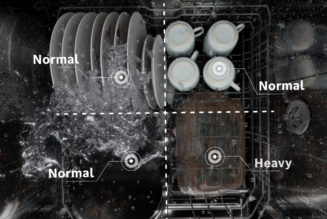NASA’s Orion spacecraft has made it past the Moon as part of the uncrewed Artemis I mission, firing its engines to pass within 81 miles of the lunar surface, and is operating with high accuracy.
The spacecraft performed an outbound powered flyby burn yesterday, Monday, November 21st, completing its closest flyby. The engines “all worked perfectly,” said Judd Frieling, a flight director at NASA’s Johnson Space Center, in a press conference. With three trajectory correction burns performed, the spacecraft has now fired all three of its thruster types: its large orbital maneuvering system engine, small reaction control system thrusters, and medium-sized auxiliary engines.
Now Orion is traveling onward to its next target, a distant retrograde orbit beyond the Moon where it will spend approximately one week. To get there, the spacecraft will perform a second engine burn on Friday, November 25th, pushing it to around 57,000 miles beyond the Moon. It will then enter an orbit traveling the opposite way around the Moon from the direction in which the Moon orbits around the Earth.
The advantage of this distant orbit is that it uses little fuel, allowing Orion to stay there for around a week. During this time, Orion’s systems will be tested to check that they are ready for an eventual crewed mission called Artemis II.
According to NASA, the spacecraft has used 76 pounds less fuel than expected, meaning it has a little more breathing room available for the rest of the mission.
:format(webp)/cdn.vox-cdn.com/uploads/chorus_asset/file/24219993/earthset_screenshot.png)
NASA also shared results from its review of the launch of the Orion spacecraft and Space Launch System rocket, which took place last week.
“The results were eye-watering,” said Mike Sarafin, Artemis I mission manager, in a press conference. “The rocket performed and / or exceeded expectations.” He went on to say that all the results were either as predicted or off by less than 0.3 percent.
However, there was an issue with the mobile launcher for the Space Launch System. The mobile launcher is the structure consisting of a base and tower which provides power and fuel to the rocket while on the ground. It was somewhat discolored and damaged in the launch. “The mobile launcher itself has a little bit of damage to it, but it will be ready to fly the crewed launch on Artemis II,” Sarafin said. The damage was around the mobile launcher deck, which was hit by exhaust from the boosters at a temperature of 3,000 degrees Fahrenheit.
Most of the deck was protected by systems designed to keep the hardware safe, but there was some damage to an elevator in the tower. “We had the world’s most powerful rocket, and the pressure basically blew the doors off our elevators,” Sarafin said. “Right now, the elevators are inoperable.”
There was also some damage to the pneumatic lines, and an investigation did find one piece of silicon material called RTV from the Orion spacecraft on the pad, which could have come loose either during launch or during Hurricane Nicole, which had previously caused some damage to the spacecraft.
Overall, officials said that the issues with the ground system were minor and will be repairable before the next flight of Space Launch System for the Artemis II mission, currently scheduled for 2024. Artemis I’s mission will continue until December 11th, when it will splash down in the ocean.









